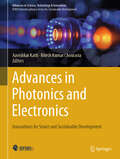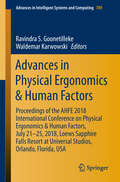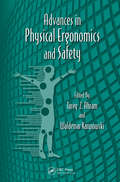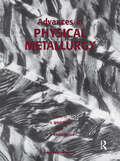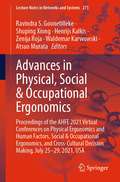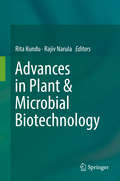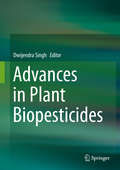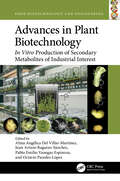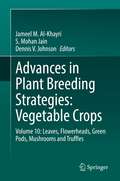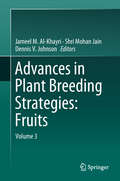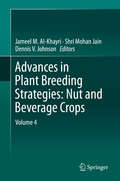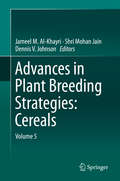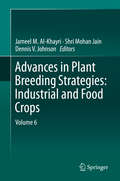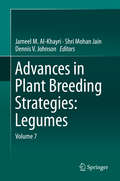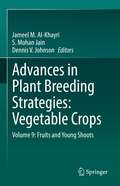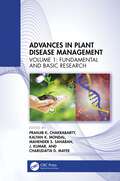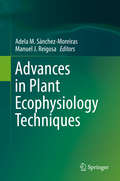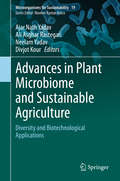- Table View
- List View
Advances in Photonics and Electronics: Innovations for Smart and Sustainable Development (Advances in Science, Technology & Innovation)
by Aavishkar Katti Ritesh Kumar ChourasiaThe book presents the collated and high-quality proceedings of the Conference on Recent Technologies in Electronics and Photonics held during 9-10 February 2024 at MIT-WPU, Pune, India. The main objective of this book is the introduction of recent innovations and current trends of photonics and electronics along with advanced device applications. Photonics and electronics together are shaping up to be the two main pillars of innovation for sustainable development and technological advances. The emphasis in this book will be on presenting recent application-based research in the mentioned fields rather than purely theoretical ideas. The readers will gain insights on recent innovations across many fields of photonics on one hand: laser science and nonlinear optics, photonic materials, nanophotonics, solar photovoltaics, optoelectronics, green photonics, and fiber optics and a diverse set of topics in electronics on the other: Semiconductor Electronics, Electronic Materials, Microelectronics, AI/ML, Internet of Things etc. The book is useful for early career researchers in Science and Engineering, as also university professors and industry professionals.
Advances in Physical Agents II: Proceedings of the 21st International Workshop of Physical Agents (WAF 2020), November 19-20, 2020, Alcalá de Henares, Madrid, Spain (Advances in Intelligent Systems and Computing #1285)
by Luis M. Bergasa Manuel Ocaña Rafael Barea Elena López-Guillén Pedro RevengaThe book reports on cutting-edge Artificial Intelligence (AI) theories and methods aimed at the control and coordination of agents acting and moving in a dynamic environment. It covers a wide range of topics relating to: autonomous navigation, localization and mapping; mobile and social robots; multiagent systems; human-robot interaction; perception systems; and deep-learning techniques applied to the robotics. Based on the 21st edition of the International Workshop of Physical Agents (WAF 2020), held virtually on November 19-20, 2020, from Alcalá de Henares, Madrid, Spain, this book offers a snapshot of the state-of-the-art in the field of physical agents, with a special emphasis on novel AI techniques in perception, navigation and human robot interaction for autonomous systems.
Advances in Physical Agents: Proceedings of the 19th International Workshop of Physical Agents (WAF 2018), November 22-23, 2018, Madrid, Spain (Advances in Intelligent Systems and Computing #855)
by Raquel Fuentetaja Pizán Ángel García Olaya Maria Paz Sesmero Lorente Jose Antonio Iglesias Martínez Agapito Ledezma EspinoThe book reports on cutting-edge theories and methods aimed at the control and coordination of agents acting and moving in a dynamic environment. It covers a wide range of systems, including multiagent systems, domotic agents, robotic manipulators, soccer robots, autonomous and semiautonomous robots, as well as systems for industrial applications. Advances in software agents, sensors, computer visions and other related areas are also thoroughly discussed and presented in detail. Based on the 19th edition of the International Workshop of Physical Agents (WAF 2018), held on November 22-23, 2018, in Madrid, Spain, this book offers a snapshot of the state-of-the-art in the field of physical agents, with a special emphasis on autonomous systems such as mobile robots, industrial process or other complex systems.
Advances in Physical Ergonomics & Human Factors: Proceedings of the AHFE 2018 International Conference on Physical Ergonomics & Human Factors, July 21-25, 2018, Loews Sapphire Falls Resort at Universal Studios, Orlando, Florida, USA (Advances in Intelligent Systems and Computing #789)
by Waldemar Karwowski Ravindra S. GoonetillekeThis book reports on the state of the art in physical ergonomics and addresses the design of products, processes, services, and work systems to ensure they are productive, safe, and enjoyable for people to use. The human body’s responses to physical and physiological work demands, strain injuries from repetition, vibration, force, and posture are the most common types of issues examined, along with their design implications. The book explores a wide range of topics in physical ergonomics, including the consequences of repetitive motion, materials handling, workplace safety, the usability of portable devices, design, working postures, and the work environment. Mastering physical ergonomics and safety engineering concepts is fundamental to creating products and systems that people can safely and conveniently use, as well as avoiding stresses and minimizing the risk of accidents. Based on the AHFE 2018 Conference on Physical Ergonomics and Human Factors, held on July 21–25, 2018, in Orlando, Florida, USA, this book provides readers with a comprehensive perspective on the current challenges in physical ergonomics, which is a critical aspect in the design of any human-centered technological system, and for factors influencing human performance.
Advances in Physical Ergonomics and Human Factors: Proceedings Of The Ahfe 2017 Conference On Physical Ergonomics And Human Factors, July 17-21, 2017, Los Angeles, California, Usa (Advances in Intelligent Systems and Computing #602)
by Waldemar Karwowski Ravindra S. GoonetillekeThis book reports on the state of the art in physical ergonomics and is concerned with the design of products, process, services, and work systems to assure their productive, safe, and satisfying use by people. With focus on the human body's responses to physical and physiological work demands, repetitive strain injuries from repetition, vibration, force, and posture are the most common types of issues examined, along with their design implications. The book explores a wide range of topics in physical ergonomics, which includes the consequences of repetitive motion, materials handling, workplace safety, and usability in the use of portable devices, design, working postures, and the work environment. Mastering physical ergonomics and safety engineering concepts is fundamental to the creation of products and systems that people are able to use, as well as the avoidance of stresses and minimization of the risk of accidents. Based on the AHFE 2016 International Conference on Physical Ergonomics & Human Factors, held on July 27-31, 2016 in Walt Disney World®, Florida, USA, the book provides readers with a comprehensive view of the current challenges in Physical Ergonomics, which are a critical aspect in the design of any human-centered technological system, and factors influencing human performance.
Advances in Physical Ergonomics and Human Factors: Proceedings of the AHFE 2016 International Conference on Physical Ergonomics and Human Factors, July 27-31, 2016, Walt Disney World®, Florida, USA (Advances in Intelligent Systems and Computing #489)
by Ravindra Goonetilleke Waldemar KarwowskiTaking the field of human factors and ergonomics beyond state of the art, this volume focuses on advances in the use of ergonomics modeling and on the evaluation of usability, which is a critical aspect of any human-technology system. The research described in the book's 70 chapters is an outcome of dedicated research by academics and practitioners from around the world, and across disciplines. The chapters are organized under five sections: I. Models and Methods II. Vision and Visual Displays , III. Product Design and User Interfaces IV. Input Devices and Computer Based Systems V. Individual and Environmental Technology Related Issues. This work provides an invaluable resource for evaluating products and environments and designing future ones that are intuitive, safe, and easy to use. Seven other titles in the Advances in Human Factors and Ergonomics Series are: Advances in Human Factors and Ergonomics in Healthcare Advances in Applied Digital Human Modeling Advances in Cross-Cultural Decision Making Advances in Cognitive Ergonomics Advances in Occupational, Social and Organizational Ergonomics Advances in Human Factors, Ergonomics and Safety in Manufacturing and Service Industries Advances in Neuroergonomics and Human Factors of Special Populations
Advances in Physical Ergonomics and Human Factors: Proceedings of the AHFE 2017 International Conference on Physical Ergonomics and Human Factors, July 17-21, 2017, The Westin Bonaventure Hotel, Los Angeles, California, USA (Advances in Intelligent Systems and Computing #602)
by Waldemar Karwowski Ravindra S. GoonetillekeThis book reports on the state of the art in physical ergonomics and is concerned with the design of products, process, services, and work systems to assure their productive, safe, and satisfying use by people. With focus on the human body's responses to physical and physiological work demands, repetitive strain injuries from repetition, vibration, force, and posture are the most common types of issues examined, along with their design implications. The book explores a wide range of topics in physical ergonomics, which includes the consequences of repetitive motion, materials handling, workplace safety, and usability in the use of portable devices, design, working postures, and the work environment. Mastering physical ergonomics and safety engineering concepts is fundamental to the creation of products and systems that people are able to use, as well as the avoidance of stresses and minimization of the risk of accidents. Based on the AHFE 2016 International Conference on Physical Ergonomics & Human Factors, held on July 27-31, 2016 in Walt Disney World#65533;, Florida, USA, the book provides readers with a comprehensive view of the current challenges in Physical Ergonomics, which are a critical aspect in the design of any human-centered technological system, and factors influencing human performance.
Advances in Physical Ergonomics and Safety (Advances in Human Factors and Ergonomics Series)
by Waldemar Karwowski Tareq Z. AhramBased on recent research, this book discusses physical ergonomics, which is concerned with human anatomical, anthropometric, physiological and biomechanical characteristics as they relate to physical activity. Topics include working postures, materials handling, repetitive movements, work-related musculoskeletal disorders, workplace layout, safety,
Advances in Physical Metallurgy
by Anirban BanerjeeThis volume focuses on the wealth of existing literature on physical metallurgy, and deals with materials in different states of order and the process of order evolution. It is a valuable reference by students and researchers in the field of materials science and metallurgy.
Advances in Physical, Social & Occupational Ergonomics: Proceedings of the AHFE 2020 Virtual Conferences on Physical Ergonomics and Human Factors, Social & Occupational Ergonomics and Cross-Cultural Decision Making, July 16–20, 2020, USA (Advances in Intelligent Systems and Computing #1215)
by Waldemar Karwowski Richard H. M. Goossens Ravindra S. Goonetilleke Atsuo Murata Shuping XiongThis book reports on cutting-edge findings and developments in physical, social and occupational ergonomics. It covers a broad spectrum of studies and evaluation procedures concerning physical and mental workload, work posture and ergonomic risk. Further, it reports on significant advances in the design of services and systems, including those addressing special populations, for purposes such as health, safety and education, and discusses solutions for a better and safer integration of humans, automated systems and digital technologies. The book also analyzes the impact of culture on people’s cognition and behavior, providing readers with timely insights into theories on cross-cultural decision-making, and their diverse applications for a number of purposes in businesses and societies. Based on three AHFE 2020 conferences (the AHFE 2020 Virtual Conference on Physical Ergonomics and Human Factors, the AHFE 2020 Virtual Conference on Social & Occupational Ergonomics, and the AHFE 2020 Virtual Conference on Cross-Cultural Decision Making), it provides readers with a comprehensive overview of the current challenges in physical, social and occupational ergonomics, including those imposed by technological developments, highlights key connections between them, and puts forward optimization strategies for sociotechnical systems, including their organizational structures, policies and processes.
Advances in Physical, Social & Occupational Ergonomics: Proceedings of the AHFE 2021 Virtual Conferences on Physical Ergonomics and Human Factors, Social & Occupational Ergonomics, and Cross-Cultural Decision Making, July 25-29, 2021, USA (Lecture Notes in Networks and Systems #273)
by Waldemar Karwowski Ravindra S. Goonetilleke Atsuo Murata Shuping Xiong Henrijs Kalkis Zenija RojaThis book reports on cutting-edge findings and developments in physical, social and occupational ergonomics. It covers a broad spectrum of studies and evaluation procedures concerning physical and mental workload, work posture and ergonomic risk. Further, it reports on significant advances in the design of services and systems, including those addressing special populations, for purposes such as health, safety and education, and discusses solutions for a better and safer integration of humans, automated systems and digital technologies. The book also analyzes the impact of culture on people’s cognition and behavior, providing readers with timely insights into theories on cross-cultural decision-making, and their diverse applications for a number of purposes in businesses and societies. Based on the AHFE 2021 conferences on Physical Ergonomics and Human Factors, Social & Occupational Ergonomics, and Cross-Cultural Decision Making, held virtually on 25–29 July, 2021, from USA, it provides readers with a comprehensive overview of the current challenges in physical, social and occupational ergonomics, including those imposed by technological developments, highlights key connections between them, and puts forward optimization strategies for sociotechnical systems, including their organizational structures, policies and processes.
Advances in Plant & Microbial Biotechnology
by Rita Kundu Rajiv NarulaBiotechnology refers to the use or manipulation of an organism or parts of an organism. While the early applications were certainly simpler (though still relevant), modern plant biotechnology is primarily associated with molecular biology, cloning and genetic engineering. Over the last 50 years, several key discoveries have revolutionized the biological sciences and enabled the rapid growth of the biotechnology industry.This book gathers handpicked articles presented by national and international scientists at the International Conference on Biotechnology and Biological Sciences, BIOSPECTRUM 2017. It highlights the works of researchers and students in India and abroad on plant biotechnology and its applications in addressing various agricultural and food production-related issues.The respective papers explore a range of advances in plant biotechnology, e.g.: the cytotoxic potential of Moringaoleifera lam; the use of the entomo-pathogenic fungi Cordyceps sp. as unique and valuable sources of bioactive compounds; and strain improvement strategies for Cordyceps sp. In addition, they discuss the use of low-cost blue green algal biofertilizer comprising four blue green algal strains in rice fields; and the use of lignocellulosic materials as potential renewable energy resources for the production of fuels.This book will be extremely useful for researchers and students of biotechnology and plant science, providing an essential update on the latest findings and trends.
Advances in Plant Biopesticides
by Dwijendra SinghThe 'Advances in Plant Biopesticides' comprises 19 chapters on different important issues of developing biopesticides from promising botanicals and its phytomolecules based on the research reviews in the area concern. The book is written by reputed scientists and professors of both developed and developing countries namely Australia, Canada, Czech Republic, Egypt, Greece, India, Kenya, Thailand, Turkey, United Kingdom, and USA represented by almost 53 contributors. The book is organized and presented in such a form that the readers can acquire and enhance their knowledge in plant biopesticide bioresources, its application in different areas to manage pests and diseases of field crops, stored products with status of exploring in Africa, non-target effects on beneficial arthropods, control of arthropods of veterinary and vectors of communicable diseases, efficacy in controlling honeybee mite pests, prospect of applying new tools to enhance the efficacy of plant biopesticides through use of nanotechnology, most important plant derived active principle as source of biopesticides, possible mode of action of phytochemicals against arthropods, limitation, production status, consumption, formulation, registration and quality regulation of plant biopesticides and have been cited by important scientific references. Most importantly, the book also highlights a unique example for developing biopesticides based on the research on Annonaceae as potential source of plant biopesticide, exploiting phytochemicals for developing green technology for sustainable crop protection strategies to withstand climate change with example in Africa, and overview in developing insect resistance to plant biopesticides. Most of the chapter contributing authors are internationally reputed researchers and possess experiences of more than three to four decades in the area of plant biopesticides. The contributing and corresponding authors of the book - Advances in Plant Biopesticides proposed and identified by the editor (Dwijendra Singh) include distinguished professors and reputed scientists from different continents of the world namely MB Isman (Canada), Nadia Z Dimetry (Egypt), Zeaur R Khan (Kenya), John A Pickett (UK), Gadi VP Reddy (USA), S Gopalakrishnan (India), Anand Prakash (India), Chirantan Chattopadyay (India), Christos G Athanassiou (Greece), Philip C. Stevenson (UK), S Raguraman (India), S Ghosh (India), Mir S Mulla (USA), Apiwat Tawatsin (Thailand), Dwijendra Singh (India), K Sahayaraj (India), Suresh Walia (India), T Shivanandappa (India), Roman Pavela (Czeck Republic), Errol Hasan (Australia), Ayhan Gokce (Turkey), SK Raza (India), and their colleague co-contributors. This book would certainly provide the updated knowledge to global readers on plant biopesticides as one of the important reference source and would stimulate to present and future researchers, scientists, student, teachers, entrepreneurs, and government & non-government policy makers interested to develop new & novel environmentally safe plant biopesticides world over.
Advances in Plant Biotechnology: In Vitro Production of Secondary Metabolites of Industrial Interest (Food Biotechnology and Engineering)
by Alma Angélica Del Villar-Martínez, Juan Arturo Ragazzo-Sánchez, Pablo Emilio Vanegas-Espinoza, and Octavio Paredes-LópezThe goal of Advances in Plant Biotechnology is to integrate the most recent knowledge on tissue culture, secondary metabolites production under controlled conditions, scaling up to produce them at bioreactor level, and their industrial applications. The biosynthetic pathways and the factors that affect them and the accumulation of metabolites, including metabolomics in medicinal plants, are key components as well. Several extraction and encapsulation technological procedures are reviewed. The structure and function of metabolites from selected commercial crops are reported in detail. Finally, items of paramount importance, such as bioavailability and stability of metabolites in pharma and food products are deeply analyzed.Key Features: Strategies for obtaining selected metabolites through in vitro culture Application of biotechnological and bioengineering principles to the management of plant metabolites Description of the encapsulation of selected metabolites Bioavailability and stability of metabolites in pharma, food, and industrial sectors This book is mainly addressed to research scientists, technical staff, and private and public organizations involved in plant biotechnology and in its processing industries. Last, but not least, students at all levels and postdoctoral researchers have received special attention from all editors and authors in this publication.
Advances in Plant Breeding Strategies: Volume 10: Leaves, Flowerheads, Green Pods, Mushrooms and Truffles
by S. Mohan Jain Jameel M. Al-Khayri Dennis V. JohnsonPlant breeders and geneticists are under constant pressure to sustain and expand food production by using innovative breeding strategies and introducing minor crops, which are well adapted to marginal lands, provide a source of nutrition, and have abiotic and biotic stress tolerance, to feed an ever-increasing human population. The basic concept of this book is to examine the use of innovative methods, augmenting traditional plant breeding, towards the improvement and development of new crop varieties, under the increasingly limiting environmental and cultivation factors, to achieve sustainable agricultural production and enhanced food security. Three volumes of the book series Advances in Plant Breeding Strategies were published in 2015, 2016 and 2018, respectively: Volume 1. Breeding, Biotechnology and Molecular Tools; Volume 2. Agronomic, Abiotic and Biotic Stress Traits and Volume 3. Fruits. In 2019, the following four volumes were published: Volume 4. Nut and Beverage Crops, Volume 5. Cereals, Volume 6. Industrial and Food Crops and Volume 7. Legumes. In 2021, three volumes are being concurrently published: Volume 8. Vegetable Crops: Bulbs, Roots and Tubers, Volume 9. Vegetable Crops: Fruits and Young Shoots and Volume 10. Vegetable Crops: Leaves, Flowerheads, Green Pods, Mushrooms and Truffles. This Volume 10, subtitled Vegetable Crops: Leaves, Flowerheads, Green Pods, Mushrooms and Truffles, consists of 14 chapters focusing on advances in breeding strategies using both traditional and modern approaches for the improvement of individual vegetable crops. Chapters are arranged in 4 parts according to the edible vegetable parts. Part I: Leaves - Chicory (Cichorium intybus L.), Chinese cabbage (Brassica rapa L. var. pekinensis), Rocket salad (Eruca vesicaria ssp. sativa Mill.), Spring onion (Allium fistulosum L.),Water spinach (Ipomoea aquatica Forsk.) and Watercress (Nasturtium officinale R. Br.); Pat II: Flowerheads and Green Pods - Cauliflower (Brassica oleracea var. botrytis L.), Globe artichoke (Cynara cardunculus var. scolymus L.), Garden pea (Pisum sativum L.) and Yardlong bean (Vigna unguiculata (L.) Walp. ssp. sesquipedalis (L.) Verdc.); Part III: Mushrooms - Enoki mushroom (Flammulina velutipes (Curtis) Singer) and Shiitake mushroom (Lentinula edodes (Berk.) Sing.); Part IV: Truffles - Desert truffles (Terfezia spp.) and White truffle (Tuber magnatum Picco and T. borchii Vittad.). Each chapter comprehensively reviews the contemporary literature on the subject and reflects the experiences of the authors. Chapters are written by internationally-reputable scientists and subjected to a review process to assure quality presentation and scientific accuracy. Each chapter begins with an introduction covering related backgrounds and provides in-depth discussion of the subject supported with high-quality color photos, illustrations and relevant data. The chapter concludes with recommendations for future research directions, a comprehensive list of pertinent references to facilitate further reading, and appendixes of genetic resources and concerned research institutes. This book series is a valuable resource for advanced students, researchers, scientists, commercial producers and seed companies as well as consultants and policymakers interested in agriculture, particularly in modern breeding technologies.
Advances in Plant Breeding Strategies: Volume 3
by Shri Mohan Jain Jameel M. Al-Khayri Dennis V. JohnsonThis book examines the development of innovative modern methodologies towards augmenting conventional plant breeding for the production of new crop varieties, under the increasingly limiting environmental and cultivation factors, to achieve sustainable agricultural production and enhanced food security. Two volumes of Advances in Plant Breeding Strategies were published in 2015 and 2016, respectively; Volume 1: Breeding, Biotechnology and Molecular Tools and Volume 2: Agronomic, Abiotic and Biotic Stress Traits. This is Volume 3: Fruits, which is focused on advances in breeding strategies for the improvement of individual fruit crops. It consists of 23 chapters grouped into three parts, according to distribution classification of fruit trees: Part I, Temperate Fruits, Part II, Subtropical Fruits, and Part III, Tropical Fruits. Each chapter comprehensively reviews the modern literature on the subject and reflects the authors' own experience.
Advances in Plant Breeding Strategies: Volume 4
by Shri Mohan Jain Jameel M. Al-Khayri Dennis V. JohnsonThis book examines the development of innovative modern methodologies towards augmenting conventional plant breeding, in individual crops, for the production of new crop varieties under the increasingly limiting environmental and cultivation factors to achieve sustainable agricultural production, enhanced food security, in addition to providing raw materials for innovative industrial products and pharmaceuticals. This Volume 4, subtitled Nut and Beverage Crops, focuses on advances in breeding strategies using both traditional and modern approaches for the improvement of individual plantation crops. Included in Part I, eleven important nut species recognized for their economical and nutritional importance including Almond, Argan, Brazil nut, Cashew nut, Chestnut, Hazelnut, Macadamia, Peanut, Pine nut, Pistachio and Walnut. Part II covers two popular beverage species, coffee and tea. This volume is contributed by 53 internationally reputable scientists from 13 countries. Each chapter comprehensively reviews the modern literature on the subject and reflects the authors own experience.
Advances in Plant Breeding Strategies: Volume 5
by Shri Mohan Jain Jameel M. Al-Khayri Dennis V. JohnsonThis book examines the development of innovative modern methodologies towards augmenting conventional plant breeding, in individual crops, for the production of new crop varieties under the increasingly limiting environmental and cultivation factors to achieve sustainable agricultural production, enhanced food security, in addition to providing raw materials for innovative industrial products and pharmaceuticals. This Volume 5, subtitled Cereals, focuses on advances in breeding strategies using both traditional and modern approaches for the improvement of individual crops. It addresses important staple food crops including barley, fonio, finger millet, foxtail millet, pearl millet, proso millet, quinoa, rice, rye, tef, triticale and spelt wheat. The volume is contributed by 53 internationally reputable scientists from 14 countries. Each chapter comprehensively reviews the modern literature on the subject and reflects the authors own experience.
Advances in Plant Breeding Strategies: Volume 6
by Shri Mohan Jain Jameel M. Al-Khayri Dennis V. JohnsonThis book examines the development of innovative modern methodologies towards augmenting conventional plant breeding, in individual crops, for the production of new crop varieties under the increasingly limiting environmental and cultivation factors to achieve sustainable agricultural production, enhanced food security, in addition to providing raw materials for innovative industrial products and pharmaceuticals. This is Vol 6, subtitled Industrial and Food Crops, which consists of two parts. Included in Part I are 11 industrial plant species utilized as sources of raw materials for the production of industrial products including pulp and wood crops (acacia), fiber (cotton, jute and ramie), rubber (guayule and rubber tree), oil (jojoba and flax), biofuels and pharmaceutical (agave) and sugar source (sugarcane). Part II covers 7 food plants selected for their utilization in food industries for the production of chocolate (cacao), cooking oil (oil palm, safflower, sesame and sunflower) and natural flavors and aroma (saffron and vanilla). This volume is contributed by 60 internationally reputable scientists from 14 countries. Each chapter comprehensively reviews the modern literature on the subject and reflects the authors own experience.
Advances in Plant Breeding Strategies: Volume 7
by Shri Mohan Jain Jameel M. Al-Khayri Dennis V. JohnsonThis book examines the development of innovative modern methodologies towards augmenting conventional plant breeding, in individual crops, for the production of new crop varieties under the increasingly limiting environmental and cultivation factors to achieve sustainable agricultural production, enhanced food security, in addition to providing raw materials for innovative industrial products and pharmaceuticals. This is Vol 7, subtitled Legumes, focuses on advances in breeding strategies using both traditional and modern approaches for the improvement of individual legume crops. Included in this volume are Adzuki bean, Black gram, Chickpea Cluster bean, Common bean, Cowpea, Faba bean, Hyacinth bean, Lentil, Mung bean, Pigeonpea and Soybean. This volume is contributed by 57 internationally reputable scientists from 9 countries. Each chapter comprehensively reviews the modern literature on the subject and reflects the authors own experience.
Advances in Plant Breeding Strategies: Volume 8: Bulbs, Roots and Tubers
by S. Mohan Jain Jameel M. Al-Khayri Dennis V. JohnsonThis book examines the development of innovative modern methodologies towards augmenting conventional plant breeding, in individual crops, for the production of new crop varieties under the increasingly limiting environmental and cultivation factors to achieve sustainable agricultural production, enhanced food security, in addition to providing raw materials for innovative industrial products and pharmaceuticals. This Volume 8, subtitled Vegetable Crops: Bulbs, Roots and Tubers, consists of 12 chapters focusing on advances in breeding strategies using both traditional and modern approaches for the improvement of individual vegetable crops. Chapters are arranged in 3 parts according to the edible vegetable parts. Part I: Bulbs - Garlic (Allium sativum L.), Leek (Allium ampeloprasum L.) and Shallot (Allium cepa L. Aggregatum group); Part II: Roots - Beetroot (Beta vulgaris ssp. vulgaris var. conditiva Alefeld), Carrot (Daucus carota L.), Parsnip (Pastinaca sativa L.), Radish (Raphanus sativus L.), Sugar beet (Beta vulgaris ssp. vulgaris L.) and Turnip (Brassica rapa var. rapa L.), Part III: Tubers - Potato (Solanum tuberosum L.) and Sweet potato (Ipomea batatas L.). The chapters were contributed by 38 internationally reputable scientists from 13 countries. Each chapter comprehensively reviews the modern literature on the subject and reflects the authors own experience.
Advances in Plant Breeding Strategies: Volume 9: Fruits and Young Shoots
by S. Mohan Jain Jameel M. Al-Khayri Dennis V. JohnsonThis book examines the development of innovative modern methodologies towards augmenting conventional plant breeding, in individual crops, for the production of new crop varieties under the increasingly limiting environmental and cultivation factors to achieve sustainable agricultural production, enhanced food security, in addition to providing raw materials for innovative industrial products and pharmaceuticals. This Volume 9, subtitled Vegetable Crops: Fruits and Young Shoots, consists of 12 chapters focusing on advances in breeding strategies using both traditional and modern approaches for the improvement of individual vegetable crops. Chapters are arranged in 2 parts according to the edible vegetable parts. Part I: Fruits - Bell Pepper (Capsicum annuum L. var. grossum Sendt.), Chili pepper (Capsicum frutescens L.), Bitter gourd (Momordica charantia L.), Bottle gourd (Lagenaria siceraria (Molina) Standl.), Eggplant (Solanum spp.), Okra (Abelmoschus esculentus L.), Plantain (Musa paradisiaca L.), Sweet gourd (Cucurbita moschata Duch. ex Poir.), Melon (Cucumis melo L. Groups Dudaim and Flexuosus), Tomato (Solanum lycopersicum L.) and Zucchini (Cucurbita pepo L.) and Part II: Young shoots - Asparagus (Asparagus officinalis L.). The chapters were contributed by 43 internationally reputable scientists from 11 countries. Each chapter comprehensively reviews the modern literature on the subject and reflects the authors own experience.
Advances in Plant Disease Management: Volume I: Fundamental and Basic Research
by Pranjib K. ChakrabartyAdvances in Plant Disease Management: Volume I: Fundamental and Basic Research is an invaluable compilation for researchers/students/stakeholders/policymakers in agriculture. The book aims to offer the latest understanding of fundamental and basic research fronts toward managing crop plants diseases. After clearly explaining the updated knowledge on the host immune system, and pathogen’s interplay with the host as unraveled through genomics, bioinformatics, and molecular studies, this book equips readers with the knowledge to confidently account for them during the formulation of management strategies for major crop plant diseases. The book offers comprehensive coverage of the research advances in plant disease management, including: Newer insight into the host-pathogen interaction, including effector-driven pathogenesis in different host-pathogen systems Updates on plant defense pathways leading to resistance to pathogens Use of novel molecules, antagonists, and genome-editing tools toward manipulating host resistance Plant protection policies that support the agricultural production system from a global perspective
Advances in Plant Ecophysiology Techniques
by Adela M. Sánchez-Moreiras Manuel J. ReigosaThis handbook covers the most commonly used techniques for measuring plant response to biotic and abiotic stressing factors, including: in vitro and in vivo bioassays; the study of root morphology, photosynthesis (pigment content, net photosynthesis, respiration, fluorescence and thermoluminiscence) and water status; thermal imaging; the measurement of oxidative stress markers; flow cytometry for measuring cell cycle and other physiological parameters; the use of microscope techniques for studying plant microtubules; programmed-cell-death; last-generation techniques (metabolomics, proteomics, SAR/QSAR); hybridization methods; isotope techniques for plant and soil studies; and the measurement of detoxification pathways, volatiles, soil microorganisms, and computational biology.
Advances in Plant Microbiome and Sustainable Agriculture: Diversity and Biotechnological Applications (Microorganisms for Sustainability #19)
by Ajar Nath Yadav Ali Asghar Rastegari Neelam Yadav Divjot KourMicrobes are ubiquitous in nature, and plant-microbe interactions are a key strategy for colonizing diverse habitats. The plant microbiome (epiphytic, endophytic and rhizospheric) plays an important role in plant growth and development and soil health. Further, rhizospheric soil is a valuable natural resource, hosting hotspots of microbes, and is vital in the maintenance of global nutrient balance and ecosystem function. The term endophytic microbes refers to those microorganisms that colonize the interior the plants. The phyllosphere is a common niche for synergism between microbes and plants and includes the leaf surface. The diverse group of microbes are key components of soil-plant systems, and where they are engaged in an extensive network of interactions in the rhizosphere/endophytic/phyllospheric they have emerged as an important and promising tool for sustainable agriculture. Plant microbiomes help to directly or indirectly promote plant growth using plant growth promoting attributes, and could potentially be used as biofertilizers/bioinoculants in place of chemical fertilizers. This book allows readers to gain an understanding of microbial diversity associated with plant systems and their role in plant growth, and soil health. Offering an overview of the state of the art in plant microbiomes and their potential biotechnological applications in agriculture and allied sectors, it is a valuable resource for scientists, researchers and students in the field of microbiology, biotechnology, agriculture, molecular biology, environmental biology and related subjects.
